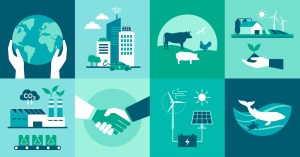The manufacturers poised for the greatest long-term growth have come to realize their focus can’t be solely on the products they make. It’s about the people who use them — and, just as importantly, the planet we all live on.
Developing a sustainability strategy is obviously good for manufacturing businesses that want to align their values with those of their customers, but it’s also simply the right thing to do. That’s why so many of them have been exploring how to make more efficient use of their resources, increases circularity and reduce waste.
This often involves considerable effort and change management within companies, as well as a solid grasp of the numbers.
Not just the financials, such as profit and loss figures that manufacturers have been tracking since their inception. Successful sustainability strategies make it necessary for companies to calculate the quantity of GHG (greenhouse gas) they emit. This provides a solid foundation for setting realistic emission-reduction targets based on a better understanding of their impact on the climate.
This is sometimes referred to greenhouse gas accounting, or more simply carbon accounting. It represents another area where the collection, management and analysis of data is critical to a manufacturing firm’s future, as well as that of the Earth itself.
Carbon Accounting Scope Emissions At A Glance
Inventorying and then auditing your organization’s GHG emissions is no small undertaking. It means evaluating your overall carbon footprint by looking at the totality of greenhouse gases you’re producing, both directly but also indirectly.
The different forms of emissions are usually categories under three different “scopes.” Emissions that stem from the vehicles a manufacturer runs or the combustion processes from its facilities, for instance, represent Scope 1. Power consumption — such as electricity, steam, cooling and heating systems — fall under Scope 2.
Then there are the Scope 3 emissions, which may be generated indirectly because of the way raw materials are processed, end-of-life remediation and simply the result of employees who travel for business purposes.
The Biggest Business Drivers For Carbon Accounting In Manufacturing
You only have to look at the Sixth Assessment Report released by the Intergovernmental Panel on Climate Change IPCC) last August. Among the key takeaways was that human influence is responsible for climate change — a conclusion that was mentioned more than 4,000 times in the report.
Much of that human influence began with the Industrial Revolution, which in turn was driven largely by the manufacturing sector. No wonder, then, that many companies in the sector are now looking at carbon accounting as one step in taking greater responsibility for solutions.
At the same time, manufacturers might be wresting with carbon accounting because their customers expect it and have made it part of the criteria to bid on new contracts.
Manufacturers also need to be mindful of how sustainability plays a role in stakeholder engagement. This could include their investors and shareholders, as well as employees who prefer to work for environmentally-friendly organizations.
The Data Challenges Carbon Accounting Presents
When manufactures and other businesses first began carbon accounting, however, they encountered some of the data management challenges that make doing your personal income taxes look like a pleasurable pastime.
Collecting all the relevant information about extrinsic and intrinsic sources of carbon emissions can involve considerable detective work, with employees chasing down details from their colleagues in other departments.
The lack of purpose-built tools for carbon accounting made matters even worse. Much like the early days of finance, those on the frontlines of driving corporate sustainability were resorting to manually imputing data in spreadsheets. This introduced plenty of risk for human error as well as providing timely reporting.
When it came time to presenting the results of carbon accounting efforts, executives and other decision-makers weren’t always sure what to make of the data in front of them. This became a barrier to launching and growing sustainability programs in businesses like manufacturing, and probably caused a lot of frustration among employees who were trying to make meaningful changes.
Why The Cloud Changes Carbon Accounting For The Better
In some respects, the lack of automation and a central source of data in carbon accounting harkened back to a similar problem in more traditional areas of business. Many companies struggled to easily capture, share and analyze their sales data, for example. Then, of course, Salesforce pioneered the notion of a cloud-based customer relationship management (CRM) platform.
Earlier this year, Salesforce announced sustainability as a core company value. This builds upon the earlier development of Sustainability Cloud, a platform to simplify processes like carbon accounting.
Recently renamed as Net Zero Cloud 2.0, the platform has now been made available globally to help companies —including Canadian manufacturers — to take action on climate change based on emissions data they can trust.
Instead of getting bogged down in spreadsheets, for example, manufactures can uses Net Cloud 2.0’s embedded guides and user flows to streamline data gathering. This includes Scope 3 emissions, which can be measured by matching categories associated with reporting based on the Greenhouse Gas Protocol with their procurement spending.
Net Zero Cloud 2.20 also includes preloaded datasets from the IPCC and other organizations to improve the accuracy of carbon accounting, and the cloud-based tool can reduce audits to a matter of hours.
If we really want to make a difference for the sake of the planet and future generations, we need carbon accounting to be comprehensive, consistent, standards-based, scaleable and efficient. That’s all possible today, and the manufactures who take advantage of the technology could become role models for sustainability across other business sectors.

























